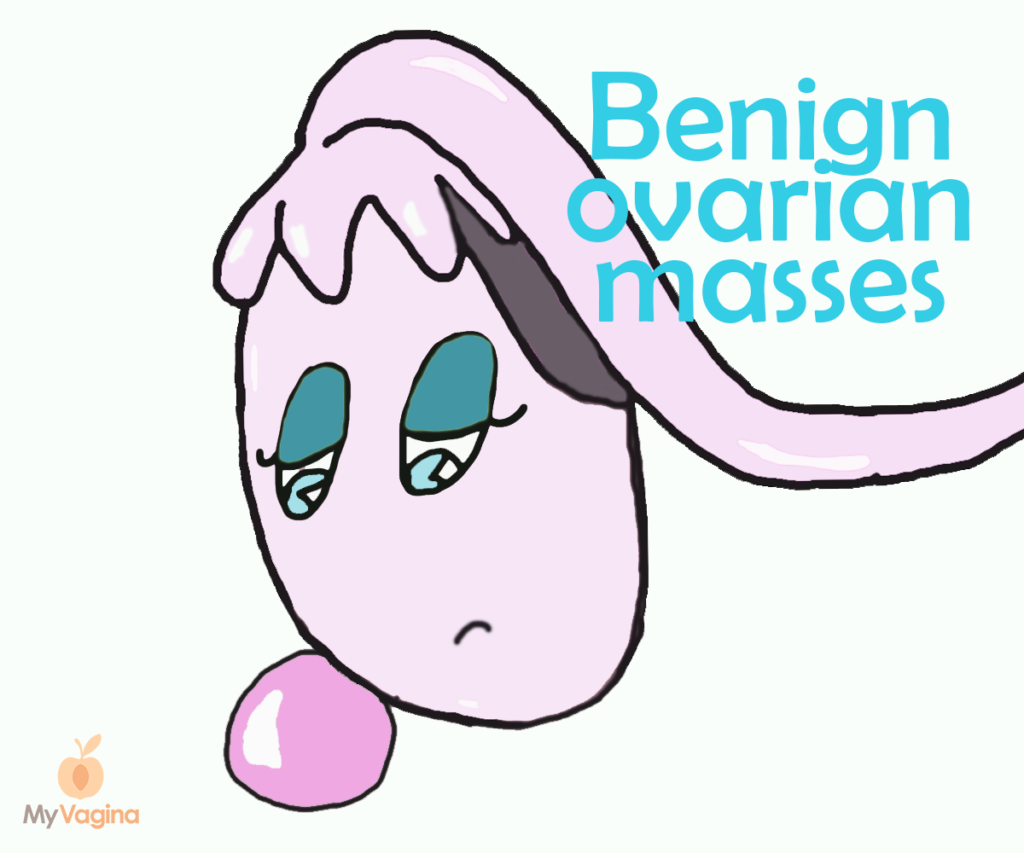A benign ovarian mass includes functional ovarian cysts and tumours. Most benign ovarian masses do not produce symptoms, and many can come and go without being noticed or requiring treatment.
The functional ovarian cyst
Functional ovarian cysts are found mostly in fertile-age women and resolve naturally over days or weeks.1,2 These ovarian cysts are less than 5cm in diameter.
- Follicular cysts – cysts that develop from graafian follicles
- Corpus luteum cysts – cysts that develop from the corpus luteum
Follicular ovarian cysts
A follicular ovarian cyst is a benign cyst in the ovary that develops from a maturing follicle. Instead of bursting to release the egg, the follicle fills with fluid. These cysts only occur in ovulating women, never after menopause, and are painless and not dangerous.
A follicular ovarian cyst will resolve on its own without intervention, but sometimes they can grow very large and burst, causing sharp pain and other symptoms. Some women are naturally more prone to these types of ovarian cysts.
Corpus luteum cysts3
A corpus luteum cyst is an ovarian cyst that contains fluid and blood, often bursting around your period. Once an egg has been released from an ovarian follicle, the corpus luteum is leftover.
The corpus luteum is a tiny gland that would normally start producing large amounts of oestrogen and progesterone to prepare for conception, but if pregnancy doesn’t occur, the corpus luteum shrivels and disappears from whence it came.
If it doesn’t shrivel back properly, it can turn into a cyst. Corpus luteum cysts can come and go without being noticed and producing no symptoms. These cysts are part of ovulating, so don’t occur past menopause or prior to puberty. They are not thought to be dangerous.
Ovarian cysts related to hormonal conditions
Ovarian cysts are most commonly associated with polycystic ovarian syndrome (PCOS). PCOS is a clinical syndrome, not just defined by ovarian cysts, but including other hormonal and clinical indicators.
These ovarian cysts are typically immature follicles that are stuck at half-mast because the hormones that would send them back inside or help them to pop to release an egg aren’t occurring properly.
Benign ovarian tumours
These tumours are typically slow-growing and rarely malignant.
- Benign cystic teratomas, dermoid cysts – consist mostly of ectodermal (embryonic) tissue4
- Fibromas – slow-growing tumours under 7cm diameter5
- Cystadenomas – serous or mucinous cysts
References
- 1.Bareghamyan H, Chopikyan A, Petrosyan M, Shahverdyan N, Harutyunyan A. Influence of ovarian cysts on ovarian reserve and fertility: A case–control study. Intl J Gynecology & Obste. Published online December 7, 2023. doi:10.1002/ijgo.15284
- 2.Christensen JT, Boldsen JL, Westergaard JG. Functional ovarian cysts in premenopausal and gynecologically healthy women. Contraception. Published online September 2002:153-157. doi:10.1016/s0010-7824(02)00353-0
- 3.Medvediev MV, Malvasi A, Gustapane S, Tinelli A. Hemorrhagic corpus luteum: Clinical management update. tjod. Published online December 1, 2020:300-309. doi:10.4274/tjod.galenos.2020.40359
- 4.Deguchy Q Jr, Fananapazir G, Corwin M, Lamba R, Gerscovich E, McGahan J. Benign Rapidly Growing Ovarian Dermoid Cysts. Journal of Diagnostic Medical Sonography. Published online August 20, 2016:71-74. doi:10.1177/8756479316664313
- 5.Thanasa A, Thanasa E, Kamaretsos E, et al. Surgical Treatment of a Rare Case of Ovarian Fibroma Associated With Elevated CA125 Levels in a Patient of Reproductive Age: A Case Report. Cureus. Published online January 23, 2023. doi:10.7759/cureus.34097

Get a fresh perspective with a qualified, experienced vulvovaginal specialist naturopath.
This product has multiple variants. The options may be chosen on the product page
The most comprehensive vaginal microbiome test you can take at home, brought to you by world-leading vaginal microbiome scientists at Juno Bio.

Promote and support a protective vaginal microbiome with tailored probiotic species.







